How to Write a Case Study: Bookmarkable Guide
VerifiedAdded on 2022/08/22
|8
|1859
|25
AI Summary
Contribute Materials
Your contribution can guide someone’s learning journey. Share your
documents today.
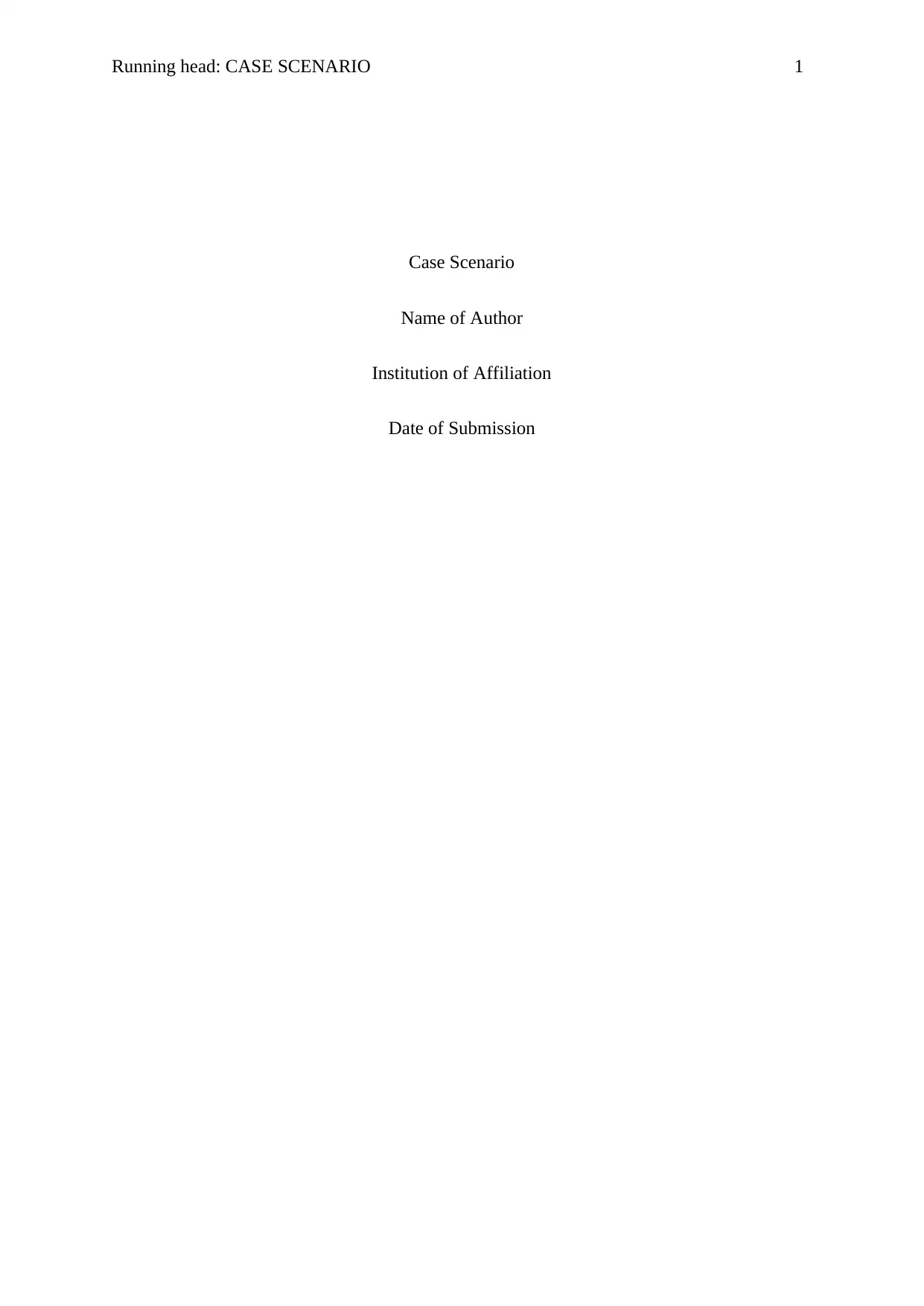
Running head: CASE SCENARIO 1
Case Scenario
Name of Author
Institution of Affiliation
Date of Submission
Case Scenario
Name of Author
Institution of Affiliation
Date of Submission
Secure Best Marks with AI Grader
Need help grading? Try our AI Grader for instant feedback on your assignments.
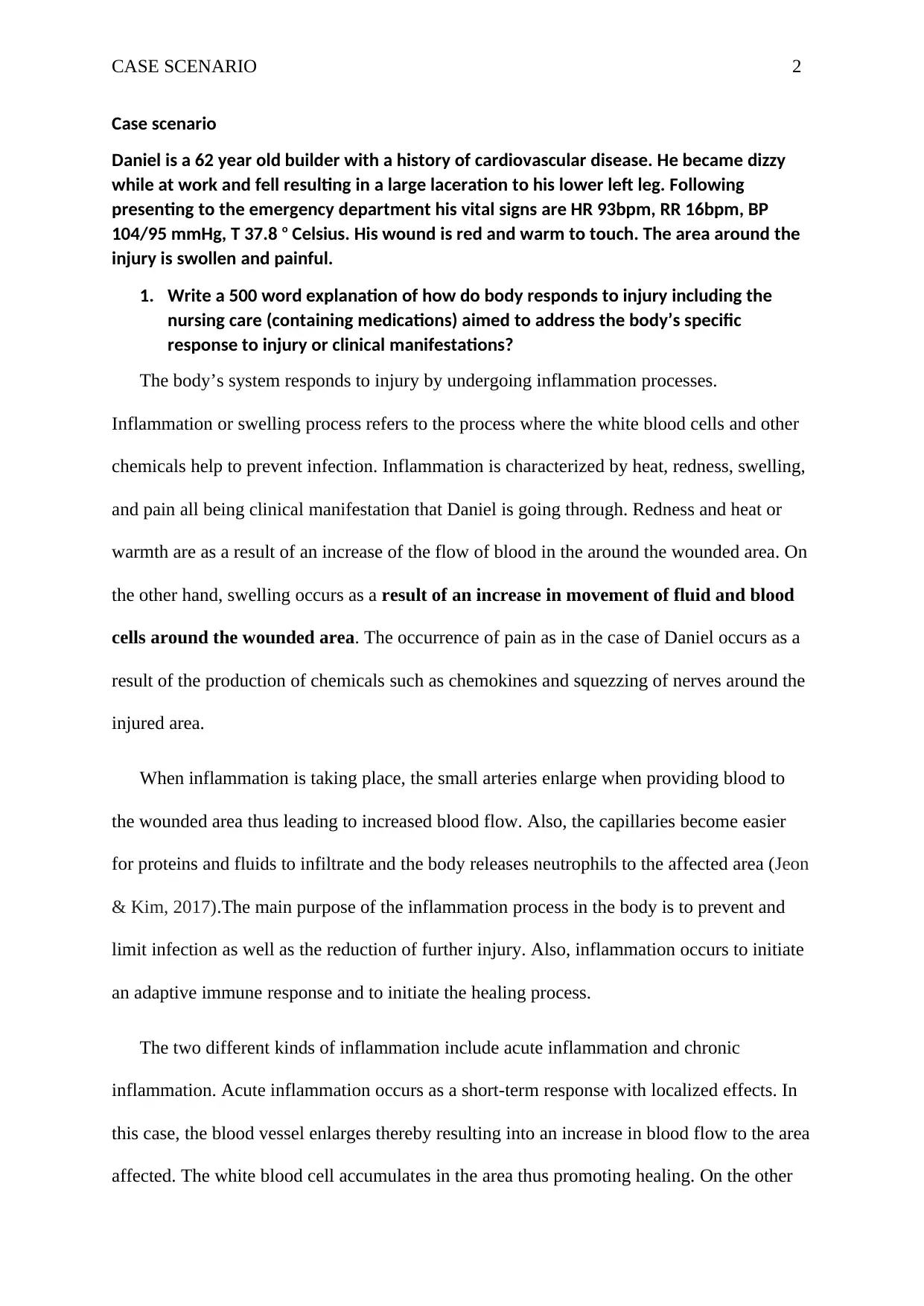
CASE SCENARIO 2
Case scenario
Daniel is a 62 year old builder with a history of cardiovascular disease. He became dizzy
while at work and fell resulting in a large laceration to his lower left leg. Following
presenting to the emergency department his vital signs are HR 93bpm, RR 16bpm, BP
104/95 mmHg, T 37.8 o Celsius. His wound is red and warm to touch. The area around the
injury is swollen and painful.
1. Write a 500 word explanation of how do body responds to injury including the
nursing care (containing medications) aimed to address the body’s specific
response to injury or clinical manifestations?
The body’s system responds to injury by undergoing inflammation processes.
Inflammation or swelling process refers to the process where the white blood cells and other
chemicals help to prevent infection. Inflammation is characterized by heat, redness, swelling,
and pain all being clinical manifestation that Daniel is going through. Redness and heat or
warmth are as a result of an increase of the flow of blood in the around the wounded area. On
the other hand, swelling occurs as a result of an increase in movement of fluid and blood
cells around the wounded area. The occurrence of pain as in the case of Daniel occurs as a
result of the production of chemicals such as chemokines and squezzing of nerves around the
injured area.
When inflammation is taking place, the small arteries enlarge when providing blood to
the wounded area thus leading to increased blood flow. Also, the capillaries become easier
for proteins and fluids to infiltrate and the body releases neutrophils to the affected area (Jeon
& Kim, 2017).The main purpose of the inflammation process in the body is to prevent and
limit infection as well as the reduction of further injury. Also, inflammation occurs to initiate
an adaptive immune response and to initiate the healing process.
The two different kinds of inflammation include acute inflammation and chronic
inflammation. Acute inflammation occurs as a short-term response with localized effects. In
this case, the blood vessel enlarges thereby resulting into an increase in blood flow to the area
affected. The white blood cell accumulates in the area thus promoting healing. On the other
Case scenario
Daniel is a 62 year old builder with a history of cardiovascular disease. He became dizzy
while at work and fell resulting in a large laceration to his lower left leg. Following
presenting to the emergency department his vital signs are HR 93bpm, RR 16bpm, BP
104/95 mmHg, T 37.8 o Celsius. His wound is red and warm to touch. The area around the
injury is swollen and painful.
1. Write a 500 word explanation of how do body responds to injury including the
nursing care (containing medications) aimed to address the body’s specific
response to injury or clinical manifestations?
The body’s system responds to injury by undergoing inflammation processes.
Inflammation or swelling process refers to the process where the white blood cells and other
chemicals help to prevent infection. Inflammation is characterized by heat, redness, swelling,
and pain all being clinical manifestation that Daniel is going through. Redness and heat or
warmth are as a result of an increase of the flow of blood in the around the wounded area. On
the other hand, swelling occurs as a result of an increase in movement of fluid and blood
cells around the wounded area. The occurrence of pain as in the case of Daniel occurs as a
result of the production of chemicals such as chemokines and squezzing of nerves around the
injured area.
When inflammation is taking place, the small arteries enlarge when providing blood to
the wounded area thus leading to increased blood flow. Also, the capillaries become easier
for proteins and fluids to infiltrate and the body releases neutrophils to the affected area (Jeon
& Kim, 2017).The main purpose of the inflammation process in the body is to prevent and
limit infection as well as the reduction of further injury. Also, inflammation occurs to initiate
an adaptive immune response and to initiate the healing process.
The two different kinds of inflammation include acute inflammation and chronic
inflammation. Acute inflammation occurs as a short-term response with localized effects. In
this case, the blood vessel enlarges thereby resulting into an increase in blood flow to the area
affected. The white blood cell accumulates in the area thus promoting healing. On the other
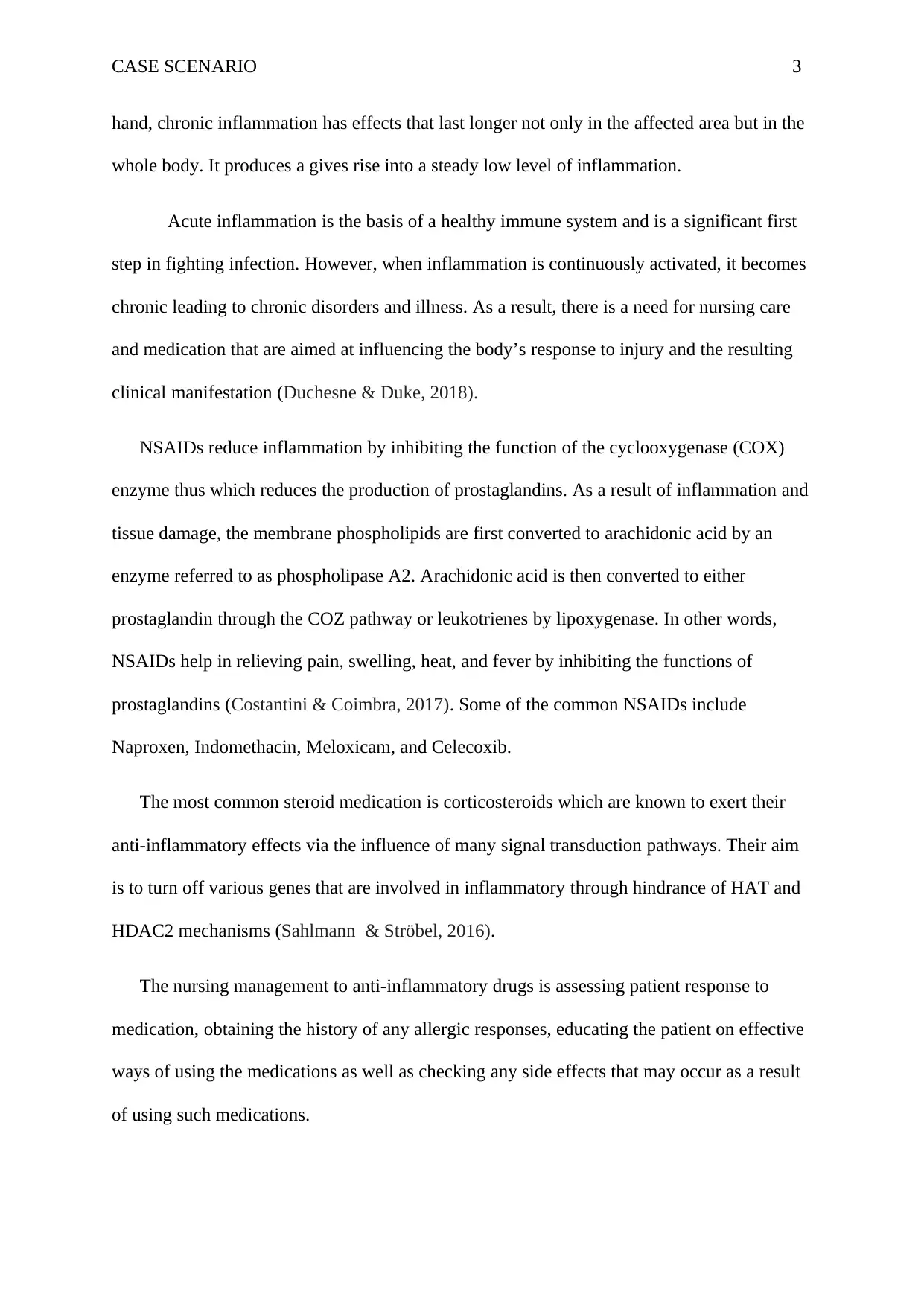
CASE SCENARIO 3
hand, chronic inflammation has effects that last longer not only in the affected area but in the
whole body. It produces a gives rise into a steady low level of inflammation.
Acute inflammation is the basis of a healthy immune system and is a significant first
step in fighting infection. However, when inflammation is continuously activated, it becomes
chronic leading to chronic disorders and illness. As a result, there is a need for nursing care
and medication that are aimed at influencing the body’s response to injury and the resulting
clinical manifestation (Duchesne & Duke, 2018).
NSAIDs reduce inflammation by inhibiting the function of the cyclooxygenase (COX)
enzyme thus which reduces the production of prostaglandins. As a result of inflammation and
tissue damage, the membrane phospholipids are first converted to arachidonic acid by an
enzyme referred to as phospholipase A2. Arachidonic acid is then converted to either
prostaglandin through the COZ pathway or leukotrienes by lipoxygenase. In other words,
NSAIDs help in relieving pain, swelling, heat, and fever by inhibiting the functions of
prostaglandins (Costantini & Coimbra, 2017). Some of the common NSAIDs include
Naproxen, Indomethacin, Meloxicam, and Celecoxib.
The most common steroid medication is corticosteroids which are known to exert their
anti-inflammatory effects via the influence of many signal transduction pathways. Their aim
is to turn off various genes that are involved in inflammatory through hindrance of HAT and
HDAC2 mechanisms (Sahlmann & Ströbel, 2016).
The nursing management to anti-inflammatory drugs is assessing patient response to
medication, obtaining the history of any allergic responses, educating the patient on effective
ways of using the medications as well as checking any side effects that may occur as a result
of using such medications.
hand, chronic inflammation has effects that last longer not only in the affected area but in the
whole body. It produces a gives rise into a steady low level of inflammation.
Acute inflammation is the basis of a healthy immune system and is a significant first
step in fighting infection. However, when inflammation is continuously activated, it becomes
chronic leading to chronic disorders and illness. As a result, there is a need for nursing care
and medication that are aimed at influencing the body’s response to injury and the resulting
clinical manifestation (Duchesne & Duke, 2018).
NSAIDs reduce inflammation by inhibiting the function of the cyclooxygenase (COX)
enzyme thus which reduces the production of prostaglandins. As a result of inflammation and
tissue damage, the membrane phospholipids are first converted to arachidonic acid by an
enzyme referred to as phospholipase A2. Arachidonic acid is then converted to either
prostaglandin through the COZ pathway or leukotrienes by lipoxygenase. In other words,
NSAIDs help in relieving pain, swelling, heat, and fever by inhibiting the functions of
prostaglandins (Costantini & Coimbra, 2017). Some of the common NSAIDs include
Naproxen, Indomethacin, Meloxicam, and Celecoxib.
The most common steroid medication is corticosteroids which are known to exert their
anti-inflammatory effects via the influence of many signal transduction pathways. Their aim
is to turn off various genes that are involved in inflammatory through hindrance of HAT and
HDAC2 mechanisms (Sahlmann & Ströbel, 2016).
The nursing management to anti-inflammatory drugs is assessing patient response to
medication, obtaining the history of any allergic responses, educating the patient on effective
ways of using the medications as well as checking any side effects that may occur as a result
of using such medications.
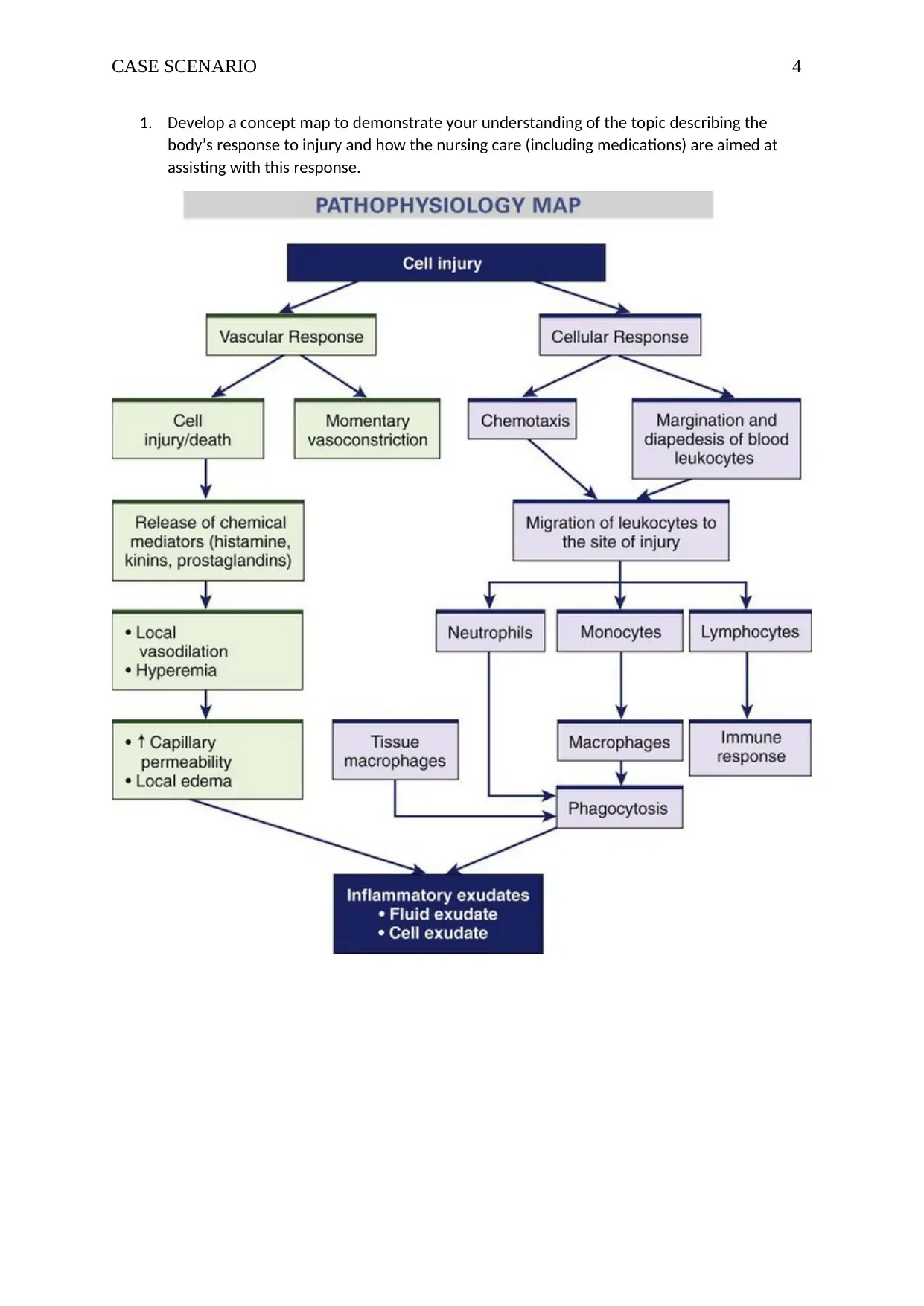
CASE SCENARIO 4
1. Develop a concept map to demonstrate your understanding of the topic describing the
body’s response to injury and how the nursing care (including medications) are aimed at
assisting with this response.
1. Develop a concept map to demonstrate your understanding of the topic describing the
body’s response to injury and how the nursing care (including medications) are aimed at
assisting with this response.
Secure Best Marks with AI Grader
Need help grading? Try our AI Grader for instant feedback on your assignments.
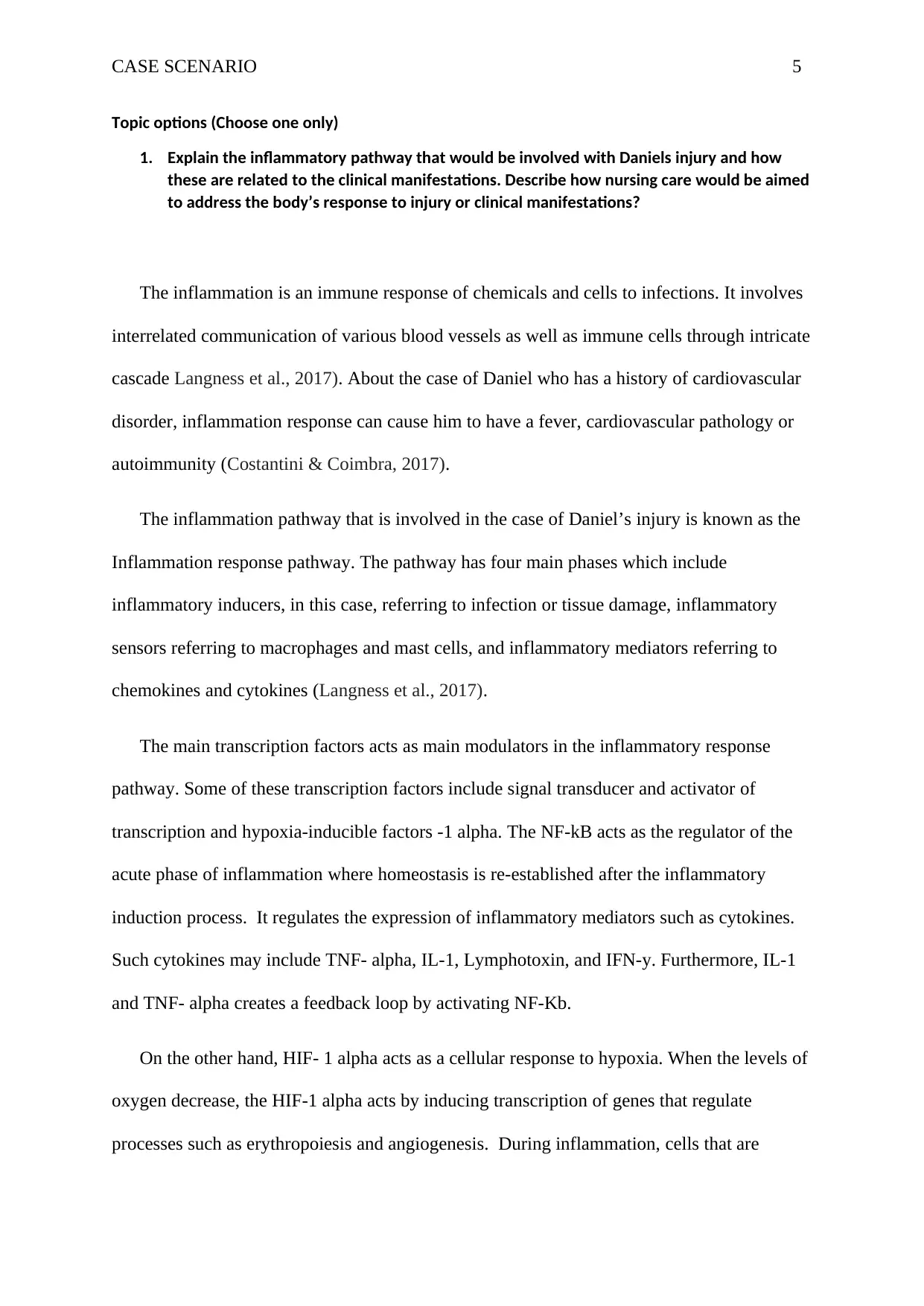
CASE SCENARIO 5
Topic options (Choose one only)
1. Explain the inflammatory pathway that would be involved with Daniels injury and how
these are related to the clinical manifestations. Describe how nursing care would be aimed
to address the body’s response to injury or clinical manifestations?
The inflammation is an immune response of chemicals and cells to infections. It involves
interrelated communication of various blood vessels as well as immune cells through intricate
cascade Langness et al., 2017). About the case of Daniel who has a history of cardiovascular
disorder, inflammation response can cause him to have a fever, cardiovascular pathology or
autoimmunity (Costantini & Coimbra, 2017).
The inflammation pathway that is involved in the case of Daniel’s injury is known as the
Inflammation response pathway. The pathway has four main phases which include
inflammatory inducers, in this case, referring to infection or tissue damage, inflammatory
sensors referring to macrophages and mast cells, and inflammatory mediators referring to
chemokines and cytokines (Langness et al., 2017).
The main transcription factors acts as main modulators in the inflammatory response
pathway. Some of these transcription factors include signal transducer and activator of
transcription and hypoxia-inducible factors -1 alpha. The NF-kB acts as the regulator of the
acute phase of inflammation where homeostasis is re-established after the inflammatory
induction process. It regulates the expression of inflammatory mediators such as cytokines.
Such cytokines may include TNF- alpha, IL-1, Lymphotoxin, and IFN-y. Furthermore, IL-1
and TNF- alpha creates a feedback loop by activating NF-Kb.
On the other hand, HIF- 1 alpha acts as a cellular response to hypoxia. When the levels of
oxygen decrease, the HIF-1 alpha acts by inducing transcription of genes that regulate
processes such as erythropoiesis and angiogenesis. During inflammation, cells that are
Topic options (Choose one only)
1. Explain the inflammatory pathway that would be involved with Daniels injury and how
these are related to the clinical manifestations. Describe how nursing care would be aimed
to address the body’s response to injury or clinical manifestations?
The inflammation is an immune response of chemicals and cells to infections. It involves
interrelated communication of various blood vessels as well as immune cells through intricate
cascade Langness et al., 2017). About the case of Daniel who has a history of cardiovascular
disorder, inflammation response can cause him to have a fever, cardiovascular pathology or
autoimmunity (Costantini & Coimbra, 2017).
The inflammation pathway that is involved in the case of Daniel’s injury is known as the
Inflammation response pathway. The pathway has four main phases which include
inflammatory inducers, in this case, referring to infection or tissue damage, inflammatory
sensors referring to macrophages and mast cells, and inflammatory mediators referring to
chemokines and cytokines (Langness et al., 2017).
The main transcription factors acts as main modulators in the inflammatory response
pathway. Some of these transcription factors include signal transducer and activator of
transcription and hypoxia-inducible factors -1 alpha. The NF-kB acts as the regulator of the
acute phase of inflammation where homeostasis is re-established after the inflammatory
induction process. It regulates the expression of inflammatory mediators such as cytokines.
Such cytokines may include TNF- alpha, IL-1, Lymphotoxin, and IFN-y. Furthermore, IL-1
and TNF- alpha creates a feedback loop by activating NF-Kb.
On the other hand, HIF- 1 alpha acts as a cellular response to hypoxia. When the levels of
oxygen decrease, the HIF-1 alpha acts by inducing transcription of genes that regulate
processes such as erythropoiesis and angiogenesis. During inflammation, cells that are
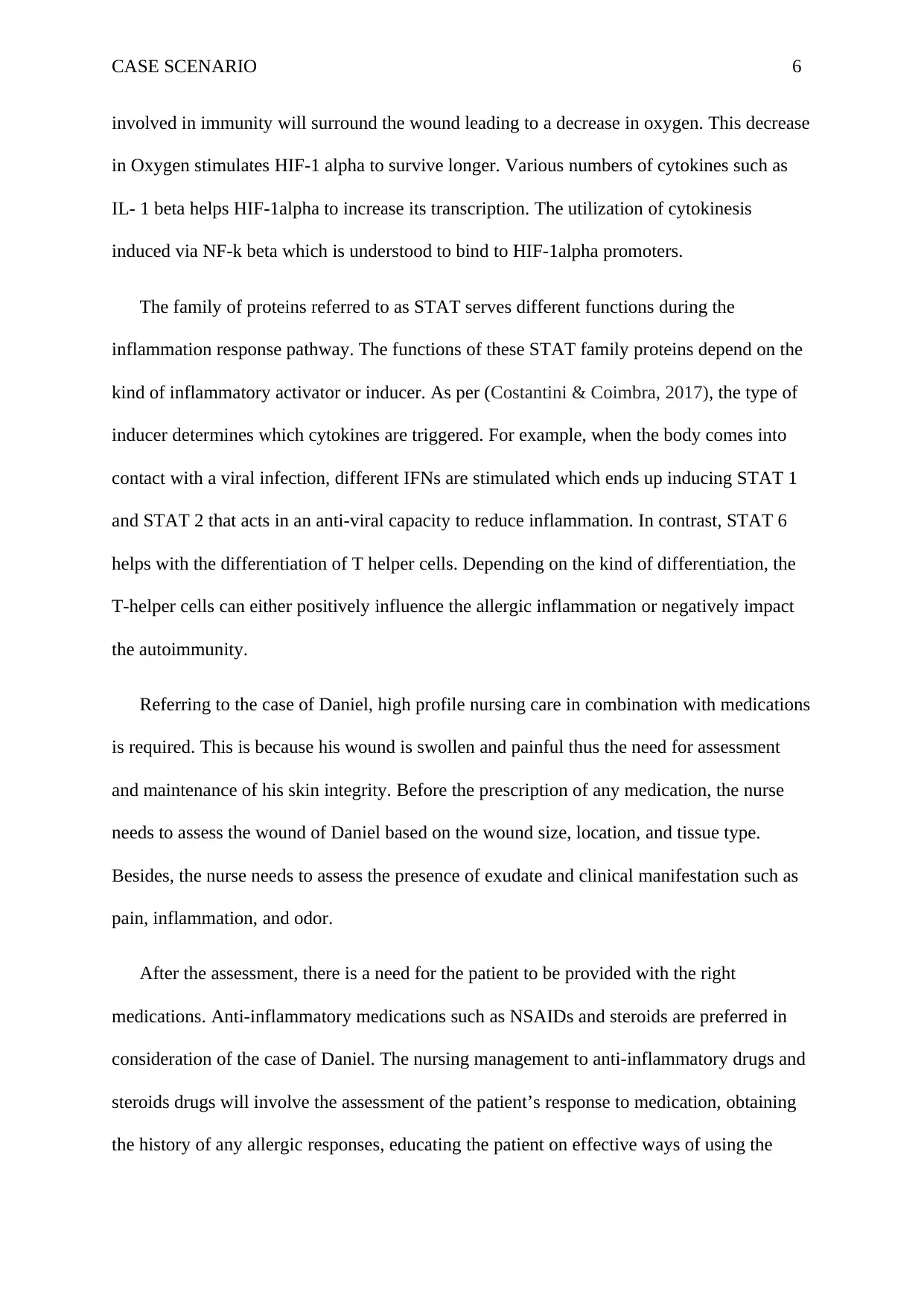
CASE SCENARIO 6
involved in immunity will surround the wound leading to a decrease in oxygen. This decrease
in Oxygen stimulates HIF-1 alpha to survive longer. Various numbers of cytokines such as
IL- 1 beta helps HIF-1alpha to increase its transcription. The utilization of cytokinesis
induced via NF-k beta which is understood to bind to HIF-1alpha promoters.
The family of proteins referred to as STAT serves different functions during the
inflammation response pathway. The functions of these STAT family proteins depend on the
kind of inflammatory activator or inducer. As per (Costantini & Coimbra, 2017), the type of
inducer determines which cytokines are triggered. For example, when the body comes into
contact with a viral infection, different IFNs are stimulated which ends up inducing STAT 1
and STAT 2 that acts in an anti-viral capacity to reduce inflammation. In contrast, STAT 6
helps with the differentiation of T helper cells. Depending on the kind of differentiation, the
T-helper cells can either positively influence the allergic inflammation or negatively impact
the autoimmunity.
Referring to the case of Daniel, high profile nursing care in combination with medications
is required. This is because his wound is swollen and painful thus the need for assessment
and maintenance of his skin integrity. Before the prescription of any medication, the nurse
needs to assess the wound of Daniel based on the wound size, location, and tissue type.
Besides, the nurse needs to assess the presence of exudate and clinical manifestation such as
pain, inflammation, and odor.
After the assessment, there is a need for the patient to be provided with the right
medications. Anti-inflammatory medications such as NSAIDs and steroids are preferred in
consideration of the case of Daniel. The nursing management to anti-inflammatory drugs and
steroids drugs will involve the assessment of the patient’s response to medication, obtaining
the history of any allergic responses, educating the patient on effective ways of using the
involved in immunity will surround the wound leading to a decrease in oxygen. This decrease
in Oxygen stimulates HIF-1 alpha to survive longer. Various numbers of cytokines such as
IL- 1 beta helps HIF-1alpha to increase its transcription. The utilization of cytokinesis
induced via NF-k beta which is understood to bind to HIF-1alpha promoters.
The family of proteins referred to as STAT serves different functions during the
inflammation response pathway. The functions of these STAT family proteins depend on the
kind of inflammatory activator or inducer. As per (Costantini & Coimbra, 2017), the type of
inducer determines which cytokines are triggered. For example, when the body comes into
contact with a viral infection, different IFNs are stimulated which ends up inducing STAT 1
and STAT 2 that acts in an anti-viral capacity to reduce inflammation. In contrast, STAT 6
helps with the differentiation of T helper cells. Depending on the kind of differentiation, the
T-helper cells can either positively influence the allergic inflammation or negatively impact
the autoimmunity.
Referring to the case of Daniel, high profile nursing care in combination with medications
is required. This is because his wound is swollen and painful thus the need for assessment
and maintenance of his skin integrity. Before the prescription of any medication, the nurse
needs to assess the wound of Daniel based on the wound size, location, and tissue type.
Besides, the nurse needs to assess the presence of exudate and clinical manifestation such as
pain, inflammation, and odor.
After the assessment, there is a need for the patient to be provided with the right
medications. Anti-inflammatory medications such as NSAIDs and steroids are preferred in
consideration of the case of Daniel. The nursing management to anti-inflammatory drugs and
steroids drugs will involve the assessment of the patient’s response to medication, obtaining
the history of any allergic responses, educating the patient on effective ways of using the
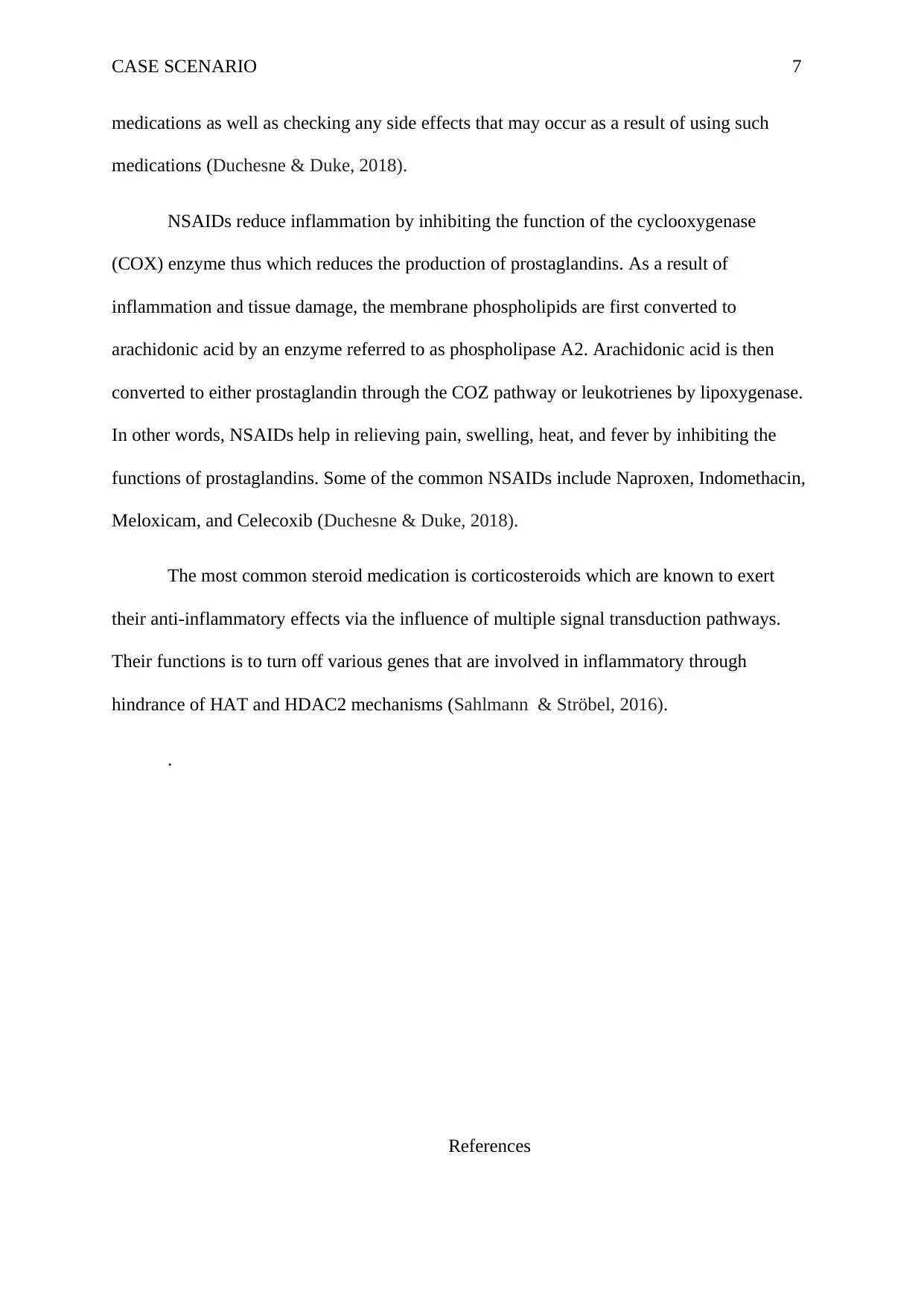
CASE SCENARIO 7
medications as well as checking any side effects that may occur as a result of using such
medications (Duchesne & Duke, 2018).
NSAIDs reduce inflammation by inhibiting the function of the cyclooxygenase
(COX) enzyme thus which reduces the production of prostaglandins. As a result of
inflammation and tissue damage, the membrane phospholipids are first converted to
arachidonic acid by an enzyme referred to as phospholipase A2. Arachidonic acid is then
converted to either prostaglandin through the COZ pathway or leukotrienes by lipoxygenase.
In other words, NSAIDs help in relieving pain, swelling, heat, and fever by inhibiting the
functions of prostaglandins. Some of the common NSAIDs include Naproxen, Indomethacin,
Meloxicam, and Celecoxib (Duchesne & Duke, 2018).
The most common steroid medication is corticosteroids which are known to exert
their anti-inflammatory effects via the influence of multiple signal transduction pathways.
Their functions is to turn off various genes that are involved in inflammatory through
hindrance of HAT and HDAC2 mechanisms (Sahlmann & Ströbel, 2016).
.
References
medications as well as checking any side effects that may occur as a result of using such
medications (Duchesne & Duke, 2018).
NSAIDs reduce inflammation by inhibiting the function of the cyclooxygenase
(COX) enzyme thus which reduces the production of prostaglandins. As a result of
inflammation and tissue damage, the membrane phospholipids are first converted to
arachidonic acid by an enzyme referred to as phospholipase A2. Arachidonic acid is then
converted to either prostaglandin through the COZ pathway or leukotrienes by lipoxygenase.
In other words, NSAIDs help in relieving pain, swelling, heat, and fever by inhibiting the
functions of prostaglandins. Some of the common NSAIDs include Naproxen, Indomethacin,
Meloxicam, and Celecoxib (Duchesne & Duke, 2018).
The most common steroid medication is corticosteroids which are known to exert
their anti-inflammatory effects via the influence of multiple signal transduction pathways.
Their functions is to turn off various genes that are involved in inflammatory through
hindrance of HAT and HDAC2 mechanisms (Sahlmann & Ströbel, 2016).
.
References
Paraphrase This Document
Need a fresh take? Get an instant paraphrase of this document with our AI Paraphraser
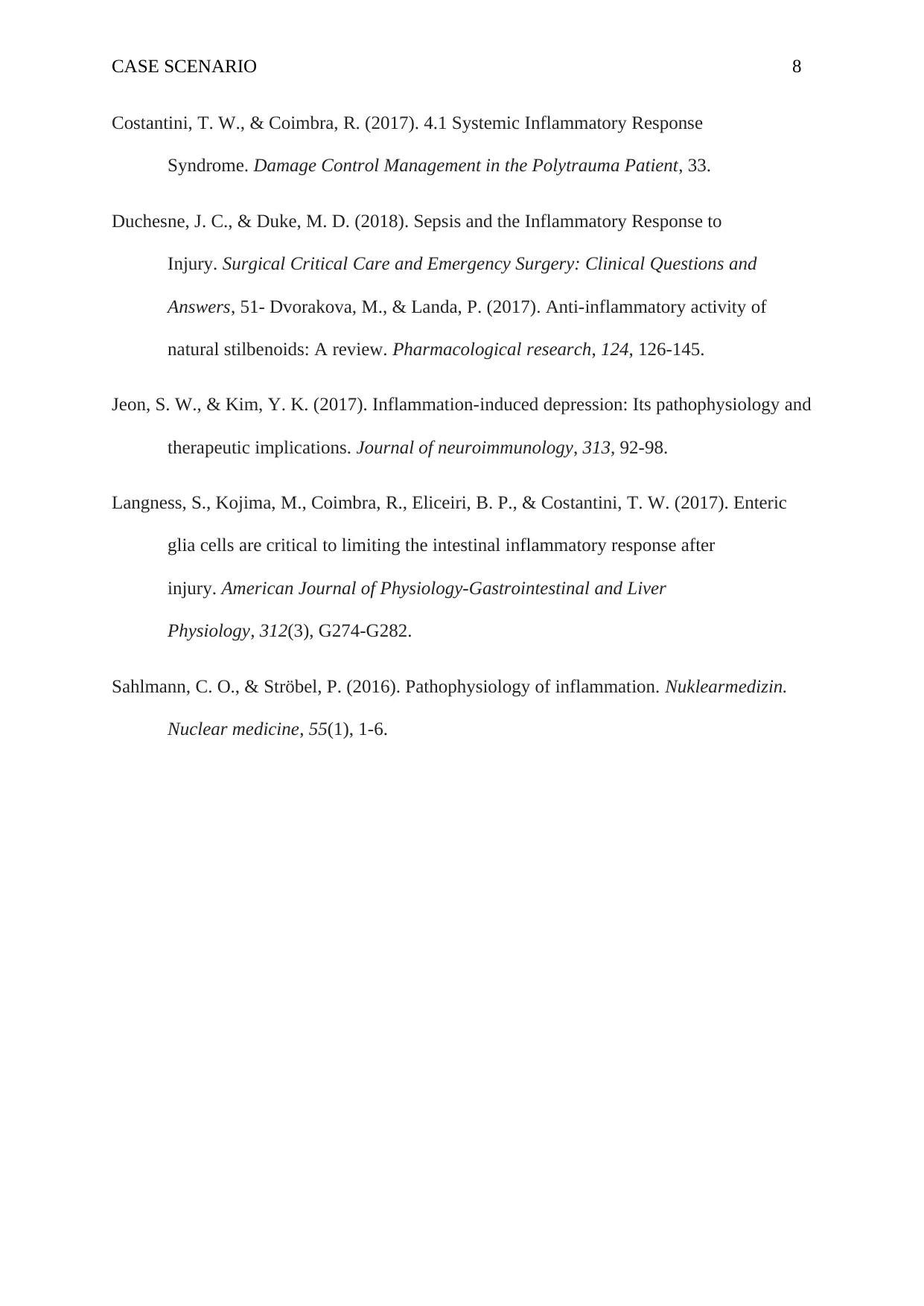
CASE SCENARIO 8
Costantini, T. W., & Coimbra, R. (2017). 4.1 Systemic Inflammatory Response
Syndrome. Damage Control Management in the Polytrauma Patient, 33.
Duchesne, J. C., & Duke, M. D. (2018). Sepsis and the Inflammatory Response to
Injury. Surgical Critical Care and Emergency Surgery: Clinical Questions and
Answers, 51- Dvorakova, M., & Landa, P. (2017). Anti-inflammatory activity of
natural stilbenoids: A review. Pharmacological research, 124, 126-145.
Jeon, S. W., & Kim, Y. K. (2017). Inflammation-induced depression: Its pathophysiology and
therapeutic implications. Journal of neuroimmunology, 313, 92-98.
Langness, S., Kojima, M., Coimbra, R., Eliceiri, B. P., & Costantini, T. W. (2017). Enteric
glia cells are critical to limiting the intestinal inflammatory response after
injury. American Journal of Physiology-Gastrointestinal and Liver
Physiology, 312(3), G274-G282.
Sahlmann, C. O., & Ströbel, P. (2016). Pathophysiology of inflammation. Nuklearmedizin.
Nuclear medicine, 55(1), 1-6.
Costantini, T. W., & Coimbra, R. (2017). 4.1 Systemic Inflammatory Response
Syndrome. Damage Control Management in the Polytrauma Patient, 33.
Duchesne, J. C., & Duke, M. D. (2018). Sepsis and the Inflammatory Response to
Injury. Surgical Critical Care and Emergency Surgery: Clinical Questions and
Answers, 51- Dvorakova, M., & Landa, P. (2017). Anti-inflammatory activity of
natural stilbenoids: A review. Pharmacological research, 124, 126-145.
Jeon, S. W., & Kim, Y. K. (2017). Inflammation-induced depression: Its pathophysiology and
therapeutic implications. Journal of neuroimmunology, 313, 92-98.
Langness, S., Kojima, M., Coimbra, R., Eliceiri, B. P., & Costantini, T. W. (2017). Enteric
glia cells are critical to limiting the intestinal inflammatory response after
injury. American Journal of Physiology-Gastrointestinal and Liver
Physiology, 312(3), G274-G282.
Sahlmann, C. O., & Ströbel, P. (2016). Pathophysiology of inflammation. Nuklearmedizin.
Nuclear medicine, 55(1), 1-6.
1 out of 8
Related Documents
Your All-in-One AI-Powered Toolkit for Academic Success.
+13062052269
info@desklib.com
Available 24*7 on WhatsApp / Email
![[object Object]](/_next/static/media/star-bottom.7253800d.svg)
Unlock your academic potential
© 2024 | Zucol Services PVT LTD | All rights reserved.





